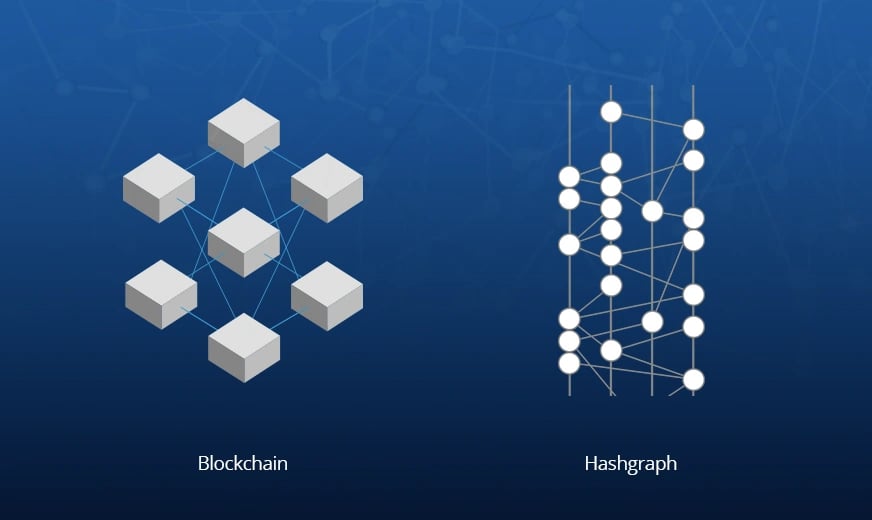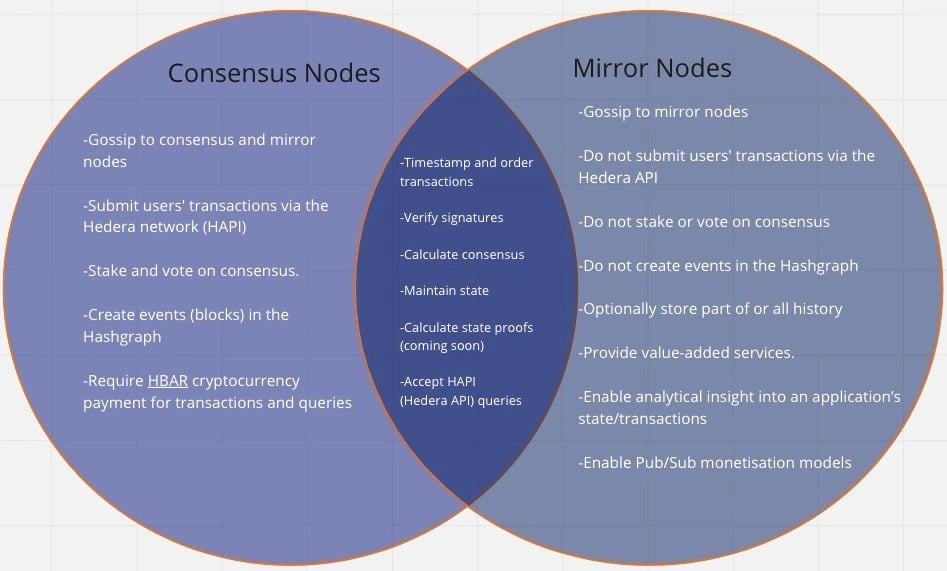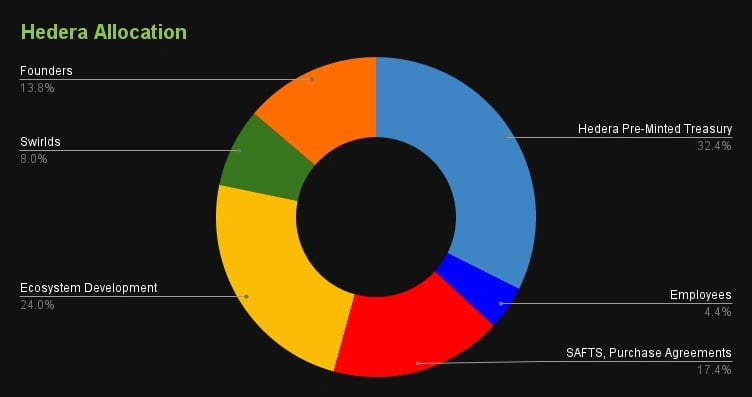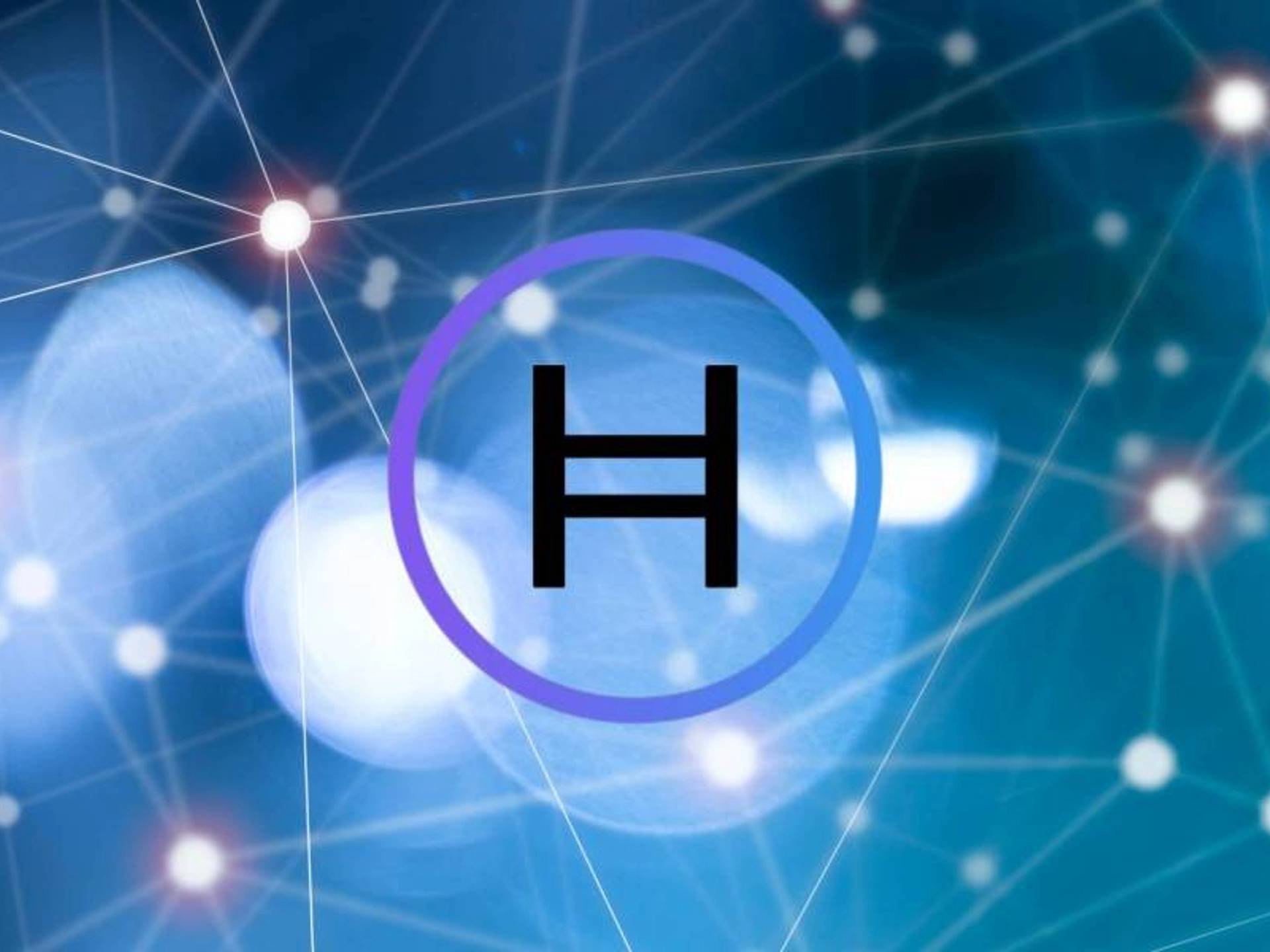위키 구독하기
Share wiki
Bookmark
Hedera
Hedera
**헤데라(Hedera)**는 기존의 블록체인 대신 해시그래프(Hashgraph) 합의 메커니즘을 사용하는 오픈소스 분산형 공개 원장입니다. 속도와 보안을 모두 향상시키기 위해 고안되었습니다. 이 플랫폼은 트랜잭션을 지원하고 분산형 애플리케이션 (Dapp) 개발을 지원하는 동시에 투명성을 제공하여 조직이 네트워크의 활동을 모니터링할 수 있도록 합니다. 또한 환경 지속 가능성에 중점을 두고 설계되었습니다. [4][5]
개요
헤데라 해시그래프는 2015년 설립자이자 전 수석 과학자인 리먼 베어드가 해시그래프 합의 알고리즘을 발명한 후 2017년에 설립되었습니다. 블록체인의 대안을 발명한 후, 베어드는 경영진 팀을 구성하고 헤데라 작업을 위한 중요한 투자를 확보했습니다. 이 회사는 2018년 3월 뉴욕시의 실제 청중과 5만 명의 가상 청중에게 제품을 선보이며 공식 데뷔했습니다. 출시 당시 헤데라는 웹사이트, 암호화폐, 관리 기구(헤데라 거버닝 위원회) 및 비전과 계획을 설명하는 백서를 소개했습니다. [6][7]
헤데라 해시그래프는 사용자가 제3자 회사(개인 정보를 수집하고 판매하는 경우가 많음) 없이 효율적이고 안전하게 온라인 거래를 관련짓고 수행할 수 있도록 하는 공개 분산 원장 기술(DLT) 네트워크로 설명됩니다. 헤데라의 목적은 광범위한 탈중앙화된 엔터프라이즈급 애플리케이션을 위한 안정적이고 신뢰할 수 있는 네트워크를 제공하는 것입니다. [2][3]
헤데라는 또한 헤데라 생태계를 강화하기 위해 네이티브 토큰인 $HBAR을 사용합니다. [2][3]
헤데라 해시그래프는 비동기 비잔틴 장애 허용(aBFT)이라는 시스템에서 작동하며, 손상된 사용자가 있어도 높은 수준의 보안을 제공합니다. 블록체인 기술에서 사용되는 일반적인 직렬 방식 대신 병렬 트랜잭션 처리 패턴을 사용하기 때문에 비트코인 및 이더리움보다 빠른 처리 속도를 자랑합니다. [8]

네트워크는 가십이라고 하는 노드 간의 정보 교환을 통해 합의에 도달합니다. 비트코인 및 기타 알트코인 네트워크의 채굴과 달리 노드는 통신하고 네트워크 트랜잭션을 확인합니다. 합의 프로토콜은 소프트웨어 업그레이드, 네트워크 가격 책정 및 재무 관리에 대한 결정을 내리는 39개의 주요 기업 및 조직으로 구성된 위원회가 감독합니다. [8]
2024년 8월 13일, 런던에 본사를 둔 암호화폐 수탁업체인 Copper는 파트너십을 통해 헤데라 블록체인에 대한 기관 접근을 확장한다고 발표했습니다. 특히 Copper는 헤데라의 토큰에 대한 수탁 및 스테이킹 서비스를 제공하고 헤데라 DeFi 생태계에 대한 온램프를 운영할 것입니다. [25]
자금 조달
2018년 8월, Hedera Hashgraph(헤데라 해시그래프)는 Hedera 공개 분산 원장 플랫폼 및 네트워크 [26]의 개발 및 사용을 더욱 발전시키기 위해 기관 및 고액 순자산가 투자자들로부터 1억 달러를 모금했습니다.
“저희는 네트워크 출시를 앞두고 있다는 사실에 매우 기쁩니다.”라고 Hedera의 공동 설립자이자 최고 과학자인 Leemon Baird 박사는 말했습니다.“투자자와 직원들의 헌신, 그리고 지속적인 커뮤니티의 강력한 지원에 감사드립니다. 또한, 개발자 커뮤니티가 저희 성장에 있어 놀라운 역할을 하고 있으며 앞으로도 계속해서 중요한 역할을 할 것이라는 점을 인정하고 싶으며, 올해 네트워크를 출시하면서 개발자들이 토큰을 획득할 수 있는 기회를 제공할 것입니다.”
2022년 3월, HBAR 재단은 2022년 한 해 동안 다양한 프로젝트에 자금을 지원하기 위해 1억 5,500만 달러 규모의 암호화폐 경제 펀드를 발표했습니다. HBAR에 따르면, 이 자금은 Hedera 생태계 개발에 사용될 것이며, 6,000만 달러는 DEX 유동성 보상에 할당될 예정입니다. [28]
“저희의 목표는 DeFi 생태계를 Hedera로 가져와 사용자들이 규모와 저렴한 비용의 이점을 누릴 수 있도록 하는 것입니다.”라고 HBAR 재단 CEO Shayne Higdon은 말했습니다.“더 많은 기관과 소비자가 토큰 발행, 자산 교환 및 암호화폐 경제 참여를 위해 Hedera를 이용함에 따라 이러한 수준의 비용, 성능 및 규모는 매우 중요합니다.”
해시그래프 합의 알고리즘
헤데라 해시그래프는 분산 네트워크 전반에 걸쳐 트랜잭션 기록에 대한 합의를 유지하기 위해 해시그래프 합의 메커니즘을 사용합니다. 이 메커니즘은 합의 노드와 미러 노드의 두 가지 유형의 노드에 의해 지원됩니다. [9]
합의 노드는 헤데라 거버닝 위원회(Hedera Governing Council)에 의해 관리되며 트랜잭션 순서 및 기록을 결정하는 역할을 하는 반면, 미러 노드는 허가가 필요 없으며 네트워크 전반에 걸쳐 다른 참여자에게 이 정보를 전파하는 역할을 합니다. [9][10]

헤데라의 접근 방식은 공개 경쟁을 통해 블록을 제안하고 체인에 추가하는 더 많은 사용자에게 의존하는 기존의 블록체인과 다릅니다. 제한된 수의 노드를 사용하여 기록을 결정함으로써 헤데라의 모델은 트랜잭션 기록의 보안 및 안정성을 높이고 잠재적인 변경 또는 취소를 방지합니다. [9]
공용 및 사설 블록체인 네트워크의 장점을 결합하여 헤데라 해시그래프는 향상된 합의 메커니즘을 제공하고자 합니다. [9]
거버넌스
헤데라 해시그래프는 헤데라 거버닝 위원회(Hedera Governing Council)라고 하는 거버넌스 기구를 통해 운영됩니다. 위원회는 네트워크에서 트랜잭션 순서를 결정하는 합의 노드(consensus nodes)를 관리하는 역할을 합니다. 위원회는 구글, IBM, 보잉과 같은 유명 기업을 포함하여 39명의 회원으로 구성됩니다. [4]
위원회의 주요 기능은 소프트웨어 변경 사항에 대한 투표, 자금의 올바른 사용 보장, 그리고 여러 관할 구역에서 네트워크의 법적 지위 보호입니다. 위원회 회원 자격은 제한되어 있으며, 각 회원은 최대 두 번의 3년 임기를 수행할 수 있으며, 그 기간 동안 네트워크 및 플랫폼 결정에 대해 동등한 투표권을 갖는다는 점에 유의할 만합니다. [11]
현재 거버닝 위원회 회원들이 메인넷 노드를 운영하고 있지만, 헤데라는 향후 관심 있는 모든 당사자에게 이를 개방할 계획입니다. [4]
헤데라 거버닝 위원회
헤데라 거버닝 위원회는 2019년 1분기에 설립되었습니다. 헤데라는 2019년 3월 7일 최초 위원 5명(도이치텔레콤(Deutsche Telekom)의 T-Labs, DLA 파이퍼(DLA Piper), 마가진 루이자(Magazine Luiza), 노무라홀딩스(Nomura Holdings), 스위스콤 블록체인(Swisscom Blockchain))을 발표했습니다. [19]
2019년 8월 12일, 헤데라는 IBM과 타타 커뮤니케이션즈(Tata Communications)를 거버닝 위원회 회원으로 추가했다고 발표하며, 두 기관이 "위원회의 다양성을 확장하여 통신, 기술, 금융 서비스, 법률 및 소매 부문의 주요 기업들을 포함하게 되었다"고 밝혔습니다. [20]
“IBM과 타타 커뮤니케이션즈가 헤데라 거버닝 위원회에 합류한 것은 해시그래프 합의 메커니즘에 대한 강력한 지지이며, 헤데라 해시그래프의 거버넌스를 더욱 분산화합니다. 견고한 견제와 균형 시스템을 포함하는 당사의 거버넌스 모델은 권력이 집중될 수 없도록 보장하는 동시에 개발자가 구축할 수 있는 안정적이고 확장 가능한 플랫폼을 제공합니다.” - Mance Harmon, CEO
2021년 9월 16일, 헤데라 거버닝 위원회는 당시 약 50억 달러 상당의 107억 HBAR을 헤데라 생태계 개발에 배정할 계획을 발표했습니다. HBAR 재단은 대체불가토큰(NFT), 탈중앙화 금융(DeFi), 중앙은행 디지털화폐(CBDC), 게임 등 헤데라 네트워크 애플리케이션 개발을 위해 신생 기업 및 기타 기관에 보조금을 제공하는 것을 목표로 했습니다. 나머지 배정액은 파트너십 및 생태계 강화를 위한 기타 이니셔티브에 사용될 예정이라고 밝혔습니다. [21]
“당사의 사명은 기업가들이 디지털 기반 경제 및 생태계를 형성하여 자산, 신원, 데이터, 시장 등을 스스로 통제하는 미래에 자금을 지원하는 것입니다. 당사는 이러한 비전을 공유하는 기관 및 팀과 협력하고 지원하게 되어 기쁩니다.” - Shayne Higdon, 전무이사 겸 CEO
2022년 7월 12일, 헤데라 거버닝 위원회는 이전의 상임 집행 투표 이사 전원을 위원회 및 업계의 선출된 대표로 교체했습니다. 이들 투표 이사는 재정 감독 및 모든 기업 임원의 임명 및 감독을 포함한 기업 수준의 기업 거버넌스 유지를 담당했습니다. 새롭게 채택된 거버넌스 절차에는 거버닝 위원회가 7명의 투표 이사 중 절반을 2년 임기로 선출하는 연례 선거가 포함되어 감독의 연속성을 보장했습니다. 이사회는 기존 위원회 회원 6명과 독립 이사 1명으로 구성되었습니다. [22]
2023년 2월 7일, 델(Dell)이 고객의 블록체인 및 Web3 관련 프로젝트를 위한 분산형 애플리케이션을 개발할 계획으로 헤데라 거버닝 위원회에 합류했습니다. 위원회는 구글(Google), IBM, 도이치텔레콤(Deutsche Telekom), 보잉(Boeing), DBS, 노무라홀딩스(Nomura Holdings) 등 최대 39명의 회원으로 구성되어 있습니다. 헤데라는 보안과 안정성을 제공하는 자사의 공개 분산 네트워크에서 대기업들이 구축할 수 있도록 유치하는 것을 목표로 하고 있습니다. 델의 오랜만의 첫 번째 공개 블록체인 관련 조치는 에지 컴퓨팅과 같은 분산 환경을 위한 헤데라 네트워크에서 애플리케이션 개발을 탐색하는 것입니다. [23][24]
$HBAR
HBAR은 헤데라 해시그래프 네트워크의 공식 통화입니다. 네트워크 내에서 여러 목적으로 사용되며, 탈중앙화 애플리케이션 거래 촉진, 개인 간 거래 가능, 잠재적 악의적 행위자에 대한 네트워크 보안 유지 등이 포함됩니다. 또한, 거래 수수료 지불에도 사용되며 에너지 효율적인 암호화폐를 지원할 수 있습니다. [2]
네트워크 연료
개발자는 HBAR($HBAR)을 사용하여 HBAR 전송, 펀지블 및 대체 불가능 토큰 관리, 데이터 로깅과 같은 네트워크 서비스 비용을 지불합니다. 네트워크에 제출되는 각 트랜잭션에 대해 네트워크 노드의 대역폭, 컴퓨팅 및 스토리지에 대한 보상으로 HBAR가 사용됩니다. [3]
네트워크 보호
헤데라의 지분 증명 공개 네트워크는 거래에 대한 합의에 도달할 때 네트워크 노드에 스테이킹되거나(프록시 스테이킹은 곧 출시 예정) $HBAR을 사용하여 투표 가중치를 부여합니다. HBAR을 사용한 가중 투표는 악의적인 행위자가 합의에 악영향을 미치는 것을 어렵고 비용이 많이 들게 만듭니다. 악의적인 행위자가 합의에 악영향을 미치려면 네트워크의 총 HBAR 공급량의 3분의 1 이상을 소유하고 스테이킹해야 하는데, 이는 앞으로 5년 동안은 불가능할 것입니다. [2]
토큰화된 자산
전례 없는 디지털 자산 접근 기회를 제공하는 헤데라 해시그래프는 성능, 보안, 안정성 및 예측 가능한 저렴한 수수료를 통해 헤데라에서 기본적인 대체 가능 및 대체 불가능 자산을 활용하여 자산 토큰화를 지원합니다.[3]
토큰 경제학
HBAR 토큰의 분포는 아래와 같습니다.[13]

스테이킹
헤데라 공공 원장은 지분 증명 합의 메커니즘을 사용하여 운영됩니다. 여기서 노드의 합의에 대한 영향력은 보유한 HBAR 암호화폐의 양에 비례합니다. 거래가 검증되고 합의에 포함되려면 스테이킹된 총 HBAR의 3분의 2 이상을 나타내는 노드에 의해 검증되어야 합니다. 스테이킹 기능은 4단계로 출시되었으며, 작성 시점에 이미 처음 세 단계가 완료되었습니다. [14]
1단계: 기술적 이용 가능성
기술적 이용 가능성 단계를 통해 2022년 7월 21일부터 Hedera 테스트넷과 메인넷 모두에서 스테이킹 기능을 사용할 수 있게 되었습니다. 이 단계에서 사용자는 기술적으로 자신의 계정을 메인넷 노드에 스테이킹할 수 있었지만, 이는 노드의 합의 가중치(투표권)에 기여하지 않았습니다. 이 초기 출시의 목표는 조기 도입자에게 불공정한 이점을 주지 않고 모든 시장 참여자가 스테이킹 프로그램에 참여할 수 있는 공평한 경쟁 환경을 제공하는 것이었습니다. [14]
2단계: 생태계 개발
2단계에서는 지원되는 거래소와 지갑이 스테이킹 기능을 통합하여 사용자가 HBAR을 쉽게 스테이킹할 수 있도록 했습니다. 그러나 이 단계에서는 보상이 지급되지 않았습니다. 노드 스테이크 가시성은 매월 업데이트되었으며, 노드에 대한 스테이킹은 해당 노드의 합의 가중치(투표권)에 영향을 미쳤습니다. [14]
3단계: 스테이킹 보상 프로그램 출시
3단계는 헤데라 거버닝 위원회(Hedera Governing Council)가 스테이킹 보상을 위한 생태계가 최소한의 실행 가능한 통합 수준에 도달했다고 판단했을 때 시작되었습니다. 위원회는 연간 10억 HBAR로 설정된 보상률을 업데이트하기로 투표했으며, 메인넷은 합의된 비율로 업데이트되었습니다. 그 후 스테이킹 보상 계정은 총 2억 5천만 HBAR의 보상 임계값에 도달하면 스테이커에게 보상을 배포할 수 있게 되었습니다. [14]
4단계: 스테이킹 완전 구현
최종 단계는 노드당 스테이크 및 노드 가동 시간 기능에 대한 가시성을 위해 24시간 업데이트를 출시하는 것을 포함했습니다. 노드 스테이크 가시성은 24시간 간격으로 업데이트되며, 스테이킹된 계정은 노드가 사용 가능하고 합의에 참여하는 경우에만 보상을 받습니다. [14]
스테이킹 노드
헤데라 거버닝 위원회는 네트워크의 모든 합의 노드에 대해 최대 노드 스테이크 값의 1/4에 해당하는 최소 스테이크 임계값을 설정했습니다. 각 노드의 최대 스테이크 값은 네트워크의 총 노드 수로 나눈 총 HBAR 수로 계산됩니다. 스테이크된 계정이 보상을 받으려면 최소 노드 스테이크를 충족해야 합니다. 이 값은 향후 헤데라 거버닝 위원회의 투표로 변경될 수 있습니다.[14]
락업 기간
헤데라 네트워크에서 스테이킹에 대한 락업 기간은 없습니다. 계정의 전체 잔액은 자동으로 선택된 노드 또는 계정에 스테이킹되며, 스테이킹된 잔액은 항상 유동적입니다. 토큰의 "본딩" 또는 "슬래싱"이라는 개념은 없습니다. [14]
스테이킹 보상
첫 번째 단계에서는 스테이킹 보상률이 0으로 설정되며, 헤데라 생태계가 필요한 통합에 도달하면 헤데라 거버닝 위원회에서 업데이트합니다. 최소 스테이킹 기간은 하루(24시간)이며, 스테이킹된 계정은 최소 노드 스테이크 임계값을 충족하고 최소 스테이킹 기간 동안 스테이킹되어야 보상을 받을 수 있습니다. 스테이킹 보상 계정의 최소 잔액 임계값은 2억 5천만 HBAR이며, 헤데라 거버닝 위원회에서 투표를 통해 결정합니다. 최대 연간 보상률 상한선은 6.5%입니다. 노드에 스테이킹하여 합의 가중치를 높이고 스테이킹 계정이 기여도에 따라 보상을 받는 간접 스테이킹도 가능합니다. [14]
서비스
헤데라 컨센서스 서비스 (HCS)
헤데라 컨센서스 서비스는 웹2 및 웹3 애플리케이션을 위한 불변적이고 시계열이 기록된 이벤트의 분산형 로그를 생성하는 도구입니다. 애플리케이션은 HCS를 사용하여 자산 이전을 추적하고, 투표를 집계하고, IoT 장치를 모니터링하는 등의 작업을 수행할 수 있습니다. [15]
HCS는 공개적 신뢰와 민감한 데이터에 대한 프라이버시를 결합하여 효과적인 합의를 제공합니다. 수수료가 저렴하고 모든 프로그래밍 언어를 사용하여 개발 유연성을 제공합니다. HCS는 높은 처리량, 신뢰할 수 있는 타임스탬프 및 빠른 최종성이 필요한 애플리케이션에 대한 실시간 감사 가능 로그를 제공합니다. 또한 권한이 부여된 블록체인 네트워크에서 민감한 정보에 대한 분산형 순서 지정 및 프라이버시를 가능하게 합니다. [15]
헤데라 토큰 서비스 (HTS)
헤데라 토큰 서비스는 공개 헤데라 네트워크의 기본 토큰화 플랫폼으로, 고속, 저비용 및 규정 준수 구성을 통해 펀지블 및 논펀지블 토큰의 전송을 제공합니다. 온체인 프로그래밍 기능과 헤데라 스마트 계약 서비스와의 통합을 통해 헤데라 토큰 서비스는 결제, 금융 서비스, 공급망 관리 등 새로운 기회를 제공합니다. [16]
헤데라 토큰 서비스를 사용하여 발행된 토큰은 네트워크에 기본적으로 속하며 낮고 예측 가능한 수수료, 구성 가능한 규정 준수 및 엔터프라이즈 거버넌스를 제공합니다. 이 플랫폼은 FP Complete의 독립적인 보안 감사를 거쳐 사용자에게 안정성과 보안을 보장합니다. 헤데라 토큰 서비스를 사용하여 네트워크 효과를 주도하고 혁신적인 애플리케이션을 만드는 지갑, 마켓플레이스, 스타트업 및 기업의 성장하는 커뮤니티에 참여하십시오. [16]
Hedera Smart Contract Service (헤데라 스마트 계약 서비스)
Hedera Smart Contract service는 개발자들이 인기 있는 Solidity 언어를 사용하여 분산 애플리케이션을 생성할 수 있도록 설계되었습니다. 이 서비스는 Ethereum Virtual Machine (EVM)과 완벽하게 호환되며, Hedera 네트워크에서 변경 없이 Solidity 코드를 실행할 수 있습니다. [17]
Smart contracts (스마트 계약) on Hedera는 해시그래프 합의 알고리즘에 최적화되어 있어, 몇 초 안에 최종 확정되는 빠른 트랜잭션과 탄소 배출 없는 에너지 사용을 제공합니다. Hedera Token Service를 통해 개발자들은 토큰 교환, 거버넌스 등에 토큰이나 HBAR을 smart contracts (스마트 계약)에 통합할 수 있습니다. [17]
Smart contracts (스마트 계약)는 산업 전반에 걸쳐 투명성과 효율성을 높일 수 있는 잠재력을 제공하며, 실시간 결제, 경매, 네트워크 간 브리지, 분산 금융, 그리고 실제 세계 데이터를 위한 오라클 등에 사용될 수 있습니다. Hedera는 개발자들이 분산 애플리케이션을 쉽게 구축할 수 있도록 오픈소스 SDK, 예제, 그리고 자습서를 제공합니다. Hedera 네트워크는 또한 저렴하고, 빠르며, 환경적으로 지속 가능하고, 모든 사용자에게 공정하도록 설계되었습니다. [17]
2022년 2월 7일, Hedera는 새로운 Hedera Smart Contract Service 2.0을 출시했습니다. 새로운 버전은 Solidity 스마트 계약에 대한 지원을 개선하고, 엔터프라이즈 워크로드와 Dapp (탈중앙화 애플리케이션) 개발자의 요구 사항에 더 적합하게 만들었습니다. Hedera Smart Contract Service 2.0은 성능, 설계 결정, 그리고 개발자 경험 향상에 대한 개선 사항도 제공하며, 스마트 계약을 사용하여 상대방 위험과 중앙화된 중개자에 대한 의존성을 피할 수 있도록 합니다. [18]
의료 서비스
공공 블록체인 및 분산원장기술(DLT)의 발전으로 의료 제공자는 기존 임상시험 데이터와 환자 의료 기록 정보를 개선하는 동시에 환자 개인 정보를 보호하고 규정 준수를 충족할 수 있습니다.[2]
Hedera의 Safe Health Systems, Inc.는 델타항공, 애리조나주립대학교, 메이요 클리닉에서 15만 명 이상의 사용자가 사용하는 주요 의료 플랫폼으로, Hedera Hashgraph를 공공 분산 원장으로 선택했습니다. Hedera는 환자 정보 및 식별자의 불변하고 검증 가능한 로그를 기록하는 동시에 최종 사용자의 개인 정보를 보호합니다. 이는 환자와 고객 조직 모두의 신뢰를 높여 채택, 유지 및 플랫폼 사용률을 높입니다.[3]
경영진
- Tom Sylvester (톰 실베스터): 사장
- Betsabe Botaitis (베츠베 보타이티스): 최고재무책임자 겸 회계담당임원
- Sam Brylski (샘 브릴스키): 최고규제책임자
- Alex Popowycz (알렉스 포포위치): 최고정보보안책임자
- Gregory Schneider (그레고리 슈나이더): 법률고문
- Kate Ball (케이트 볼): 기업비서
- Shyam Nagarajan (샤얌 나가라잔): 최고운영책임자
- Nilmini Rubin (닐미니 루빈): 최고정책책임자[12]
이사회
- Tasker Generes (태스커 제너리스)
- Pradeep Iyer (프라딥 아이어)
- Brian P. Jeffords (브라이언 피. 제퍼즈)
- Brett McDowell (브렛 맥도웰)
- Monique Morrow (모니크 모로우)
- Shyam Nagarajan (샤얌 나가라잔)
- Ian Putter (이안 푸터)
- Scott Thiel[12]
잘못된 내용이 있나요?
